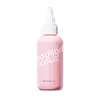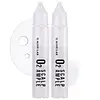What's inside
What's inside
 Key Ingredients
Key Ingredients

 Benefits
Benefits

 Concerns
Concerns

 Ingredients Side-by-side
Ingredients Side-by-side

Water
Skin ConditioningButylene Glycol
HumectantNiacinamide
SmoothingOctyldodeceth-16
EmulsifyingPolysorbate 20
EmulsifyingTromethamine
BufferingAcrylates/C10-30 Alkyl Acrylate Crosspolymer
Emulsion StabilisingMenthol
MaskingSodium Benzoate
MaskingSalicylic Acid
MaskingCaffeine
Skin ConditioningChlorella Vulgaris Extract
Skin ConditioningGlucose
HumectantPanthenol
Skin ConditioningPotassium Sorbate
PreservativeFructooligosaccharides
HumectantFructose
HumectantGlycerin
Humectant1,2-Hexanediol
Skin ConditioningMenthyl PCA
HumectantEthyl Menthane Carboxamide
TonicGlycine Soja Seed Extract
Skin ConditioningSaccharomyces Cerevisiae Extract
Skin ConditioningCaprylic/Capric Triglyceride
MaskingPropylheptyl Caprylate
EmollientHydrogenated Lecithin
EmulsifyingPropanediol
SolventPentylene Glycol
Skin ConditioningCocoglycerides
EmollientPhenyl Trimethicone
Skin ConditioningCynanchum Atratum Extract
Skin ConditioningEthylhexylglycerin
Skin ConditioningOctanediol
Caprylyl Glycol
EmollientAlthaea Rosea Flower Extract
Skin ConditioningDipotassium Glycyrrhizate
HumectantSerine
MaskingGlutamic Acid
HumectantCeramide NP
Skin ConditioningCholesterol
EmollientStearic Acid
CleansingAspartic Acid
MaskingLeucine
Skin ConditioningSh-Oligopeptide-1
Skin ConditioningSh-Polypeptide-1
Skin ConditioningSphinganine
Skin ConditioningPhosphatidylcholine
EmulsifyingAlanine
MaskingLysine
Skin ConditioningArginine
MaskingTyrosine
MaskingPhenylalanine
MaskingProline
Skin ConditioningThreonine
Valine
MaskingIsoleucine
Skin ConditioningPolyglyceryl-10 Laurate
Skin ConditioningHistidine
HumectantCysteine
AntioxidantMethionine
Skin ConditioningTocopherol
AntioxidantAcetyl Hexapeptide-8
HumectantCopper Tripeptide-1
Skin ConditioningPalmitoyl Pentapeptide-4
Skin ConditioningTripeptide-1
Skin ConditioningGlycine Soja Oil
EmollientAlanine/Histidine/Lysine Polypeptide Copper Hcl
Skin ConditioningHexapeptide-9
Skin ConditioningPalmitoyl Tripeptide-1
Skin ConditioningSh-Oligopeptide-14
Skin ConditioningSh-Oligopeptide-2
Skin ConditioningSh-Polypeptide-45
Skin ConditioningSh-Polypeptide-7
AntiseborrhoeicSh-Polypeptide-9
Skin ConditioningWater, Butylene Glycol, Niacinamide, Octyldodeceth-16, Polysorbate 20, Tromethamine, Acrylates/C10-30 Alkyl Acrylate Crosspolymer, Menthol, Sodium Benzoate, Salicylic Acid, Caffeine, Chlorella Vulgaris Extract, Glucose, Panthenol, Potassium Sorbate, Fructooligosaccharides, Fructose, Glycerin, 1,2-Hexanediol, Menthyl PCA, Ethyl Menthane Carboxamide, Glycine Soja Seed Extract, Saccharomyces Cerevisiae Extract, Caprylic/Capric Triglyceride, Propylheptyl Caprylate, Hydrogenated Lecithin, Propanediol, Pentylene Glycol, Cocoglycerides, Phenyl Trimethicone, Cynanchum Atratum Extract, Ethylhexylglycerin, Octanediol, Caprylyl Glycol, Althaea Rosea Flower Extract, Dipotassium Glycyrrhizate, Serine, Glutamic Acid, Ceramide NP, Cholesterol, Stearic Acid, Aspartic Acid, Leucine, Sh-Oligopeptide-1, Sh-Polypeptide-1, Sphinganine, Phosphatidylcholine, Alanine, Lysine, Arginine, Tyrosine, Phenylalanine, Proline, Threonine, Valine, Isoleucine, Polyglyceryl-10 Laurate, Histidine, Cysteine, Methionine, Tocopherol, Acetyl Hexapeptide-8, Copper Tripeptide-1, Palmitoyl Pentapeptide-4, Tripeptide-1, Glycine Soja Oil, Alanine/Histidine/Lysine Polypeptide Copper Hcl, Hexapeptide-9, Palmitoyl Tripeptide-1, Sh-Oligopeptide-14, Sh-Oligopeptide-2, Sh-Polypeptide-45, Sh-Polypeptide-7, Sh-Polypeptide-9
Water
Skin ConditioningPanthenol
Skin ConditioningDipropylene Glycol
HumectantButylene Glycol
HumectantDipotassium Glycyrrhizate
HumectantAllantoin
Skin ConditioningSodium Hyaluronate
HumectantBetaine
HumectantBetaine Salicylate
AntimicrobialZinc PCA
HumectantAmmonium Acryloyldimethyltaurate/Vp Copolymer
Polysorbate 80
EmulsifyingCaprylyl Glycol
EmollientPentylene Glycol
Skin ConditioningCentella Asiatica Extract
CleansingRubus Coreanus Fruit Extract
Skin ConditioningCitrus Junos Fruit Extract
Skin ConditioningCitric Acid
BufferingSodium Citrate
BufferingRosmarinus Officinalis Leaf Oil
Masking1,2-Hexanediol
Skin ConditioningWater, Panthenol, Dipropylene Glycol, Butylene Glycol, Dipotassium Glycyrrhizate, Allantoin, Sodium Hyaluronate, Betaine, Betaine Salicylate, Zinc PCA, Ammonium Acryloyldimethyltaurate/Vp Copolymer, Polysorbate 80, Caprylyl Glycol, Pentylene Glycol, Centella Asiatica Extract, Rubus Coreanus Fruit Extract, Citrus Junos Fruit Extract, Citric Acid, Sodium Citrate, Rosmarinus Officinalis Leaf Oil, 1,2-Hexanediol
Ingredients Explained
These ingredients are found in both products.
Ingredients higher up in an ingredient list are typically present in a larger amount.
1,2-Hexanediol is a synthetic liquid and another multi-functional powerhouse.
It is a:
- Humectant, drawing moisture into the skin
- Emollient, helping to soften skin
- Solvent, dispersing and stabilizing formulas
- Preservative booster, enhancing the antimicrobial activity of other preservatives
Butylene Glycol (or BG) is used within cosmetic products for a few different reasons:
Overall, Butylene Glycol is a safe and well-rounded ingredient that works well with other ingredients.
Though this ingredient works well with most skin types, some people with sensitive skin may experience a reaction such as allergic rashes, closed comedones, or itchiness.
Learn more about Butylene GlycolCaprylyl Glycol is a humectant and emollient, meaning it attracts and preserves moisture.
It is a common ingredient in many products, especially those designed to hydrate skin. The primary benefits are retaining moisture, skin softening, and promoting a healthy skin barrier.
Though Caprylyl Glycol is an alcohol derived from fatty acids, it is not the kind that can dry out skin.
This ingredient is also used as a preservative to extend the life of products. It has slight antimicrobial properties.
Learn more about Caprylyl GlycolDipotassium Glycyrrhizate comes from licorice root.
Extracts of licorice have demonstrated to have antibacterial, anti‐inflammatory, antiviral, antioxidant properties.
One component, glabridin, has extra potent antioxidant and soothing properties. It has also been found to block pigmentation from UVB rays in guinea pigs.
Licorice Root also contains a flavonoid. Flavonoids are a natural substance from in plants. Flavonoids also have antioxidant properties.
Another component, glycyrrhizin, has been found to have anti-inflammatory and antimicrobial benefits. This may make licorice root extract effective at treating acne. However, more research is needed to support this.
Liquiritin is one of the flavone compounds found in licorice. It has been found to help lighten skin by preventing tyrosinase from reacting with tyrosine. When the two react, protein is converted to melanin. Melanin is the substance in your body that gives your features pigmentation.
Licorice root is native to Southern Europe and Asia. It has been used in traditional Chinese medicine to help with respiratory issues.
Learn more about Dipotassium GlycyrrhizatePanthenol is a common ingredient that helps hydrate and soothe the skin. It is found naturally in our skin and hair.
There are two forms of panthenol: D and L.
D-panthenol is also known as dexpanthenol. Most cosmetics use dexpanthenol or a mixture of D and L-panthenol.
Panthenol is famous due to its ability to go deeper into the skin's layers. Using this ingredient has numerous pros (and no cons):
Like hyaluronic acid, panthenol is a humectant. Humectants are able to bind and hold large amounts of water to keep skin hydrated.
This ingredient works well for wound healing. It works by increasing tissue in the wound and helps close open wounds.
Once oxidized, panthenol converts to pantothenic acid. Panthothenic acid is found in all living cells.
This ingredient is also referred to as pro-vitamin B5.
Learn more about PanthenolPentylene glycol is typically used within a product to thicken it. It also adds a smooth, soft, and moisturizing feel to the product. It is naturally found in plants such as sugar beets.
The hydrophilic trait of Pentylene Glycol makes it a humectant. As a humectant, Pentylene Glycol helps draw moisture from the air to your skin. This can help keep your skin hydrated.
This property also makes Pentylene Glycol a great texture enhancer. It can also help thicken or stabilize a product.
Pentylene Glycol also acts as a mild preservative and helps to keep a product microbe-free.
Some people may experience mild eye and skin irritation from Pentylene Glycol. We always recommend speaking with a professional about using this ingredient in your routine.
Pentylene Glycol has a low molecular weight and is part of the 1,2-glycol family.
Learn more about Pentylene GlycolWater. It's the most common cosmetic ingredient of all. You'll usually see it at the top of ingredient lists, meaning that it makes up the largest part of the product.
So why is it so popular? Water most often acts as a solvent - this means that it helps dissolve other ingredients into the formulation.
You'll also recognize water as that liquid we all need to stay alive. If you see this, drink a glass of water. Stay hydrated!
Learn more about Water